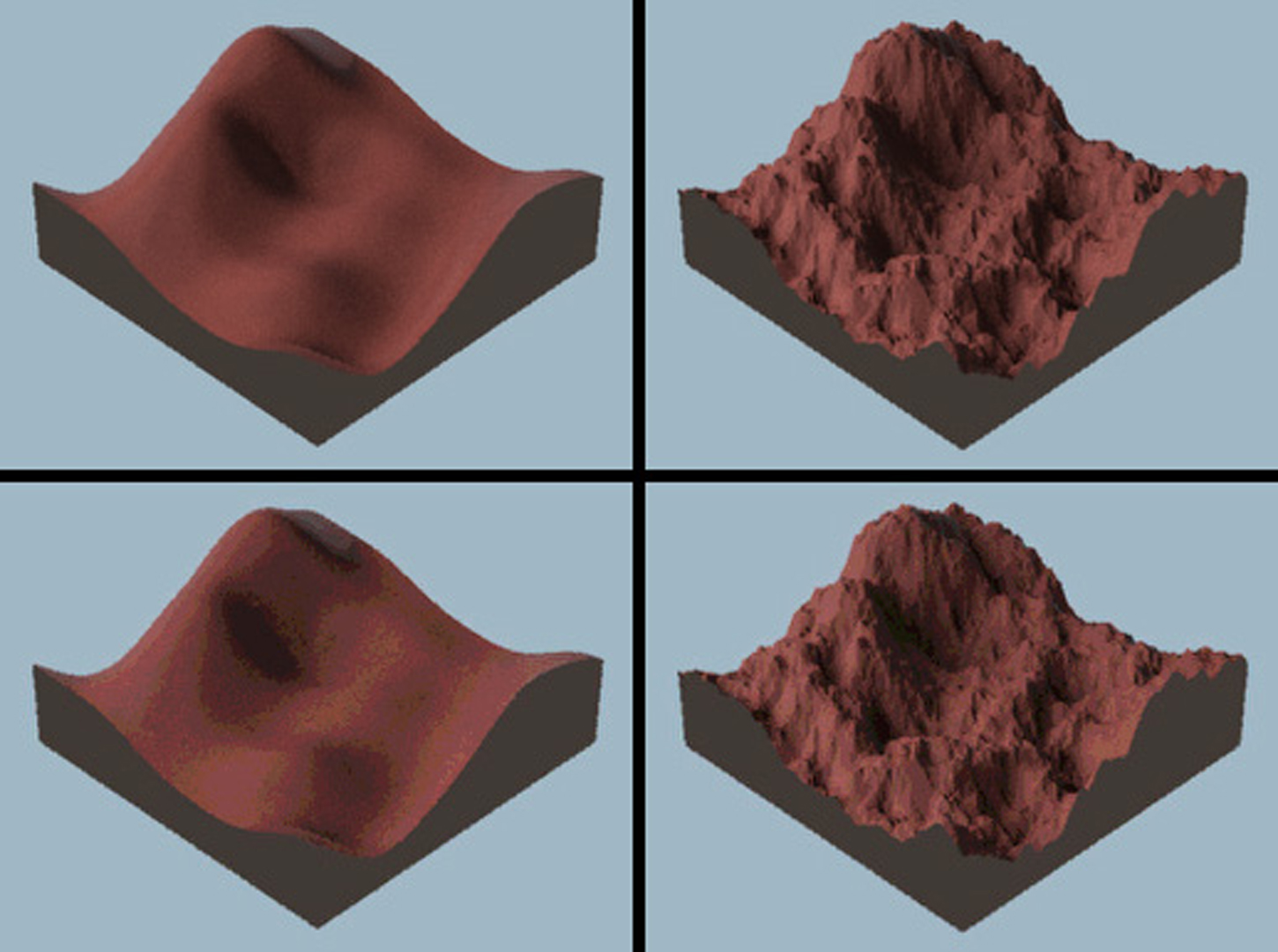“A model of visual masking for computer graphics” by Ferwerda, Shirley, Pattanaik and Greenberg
Conference:
Type(s):
Title:
- A model of visual masking for computer graphics
Presenter(s)/Author(s):
Abstract:
In this paper we develop a computational model of visual masking based on psychophysical data. The model predicts how the presence of one visual pattern affects the detectability of another. The model allows us to choose texture patterns for computer graphics images that hide the effects of faceting, banding, aliasing, noise and other visual artifacts produced by sources of error in graphics algorithms. We demonstrate the utility of the model by choosing a texture pattern to mask faceting artifacts caused by polygonal tesselation of a flat-shaded curved surface. The model predicts how changes in the contrast, spatial frequency, and orientation of the texture pattern, or changes in the tesselation of the surface will alter the masking effect. The model is general and has uses in geometric modeling, realistic image synthesis, scientific visualization, image compression, and image-based rendering.
References:
1. Arvo, J., Torrance, T., and Smits, B. (1994). A framework for the analysis of error in global illumination algorithms. Proceedings SIGGRAPH 94, 75-84.
2. Blakemore, C. and Campbell, F.W. (1969). On the existence of neurones in the human visual system selectively sensitive to the orientation and size of retinal images. J. Physiol., 203, 237-260.
3. Bolin, M.R. and Meyer, G.M. (1995). A frequency based ray tracer. Proceedings SIGGRAPH 95, 409-418.
4. Bradley, A., Switkes, E., and DeValois, K.K. (1988). Orientation and spatial frequency selectivity of adaptation to color and luminance patterns. Vision Res., 28, 841-856.
5. Campbell, F.W. and Kulikowski, J.J. (1966). Orientation selectivity of the human visual system. J. Physiol., 187, 437- 445.
6. Campbell, F.W. and Robson, J.G. (1968). Application of Fourier analysis to the visibility of gratings. J. Physiol., 197, 551-566.
7. Daly, S. (1992). The visible difference predictor: an algorithm for the assessment of image fidelity. Human Vision, Visual Processing and Digital Display, SPIE Vol. 1666, 2-15.
8. DeValois, R.L., Yund, E.W., and Hepler, N. (1982). The orientation and direction selectivity of cells in macaque visual cortex. Vision Res., 22, 531-544.
9. Dowling, J.E. and Boycott, B.B. (1966). Organization of the primate retina: electron microscopy. Proc. Royal Soc. Loud. Ser. B., 166, 80-III.
10. Enroth-Cugell, C. and Robson, J.G. (1966). The contrast sensitivity of retinal ganglion cells of the cat. J. Physiol., 187, 517-552.
11. Fletcher, H. (1952). Speech and hearing (revised ed.). New York: van Nostrand.
12. Foley, J.M. (1994). Human luminance pattern-vision mechanisms: masking experiments require a new model. J. Opt. Soc. Am. A, 11(6), 1710-1719.
13. Gegenfurther, K.R. and Kiper, D.C. (1992). Contrast detection in luminance and chromatic noise. J. Opt. Soc. Am. A, 9(11). 1880-1888.
14. Graham, N.V. (1989). Visual Pattern Analyzers. New York: Oxford University Press.
15. Harmon, L.D. and Julesz, B. (1973). Masking in visual recognition: effects of two-dimensional filtered noise. Science, 180, 1194-1197.
16. Hubel, D.H. and Wiesel, T.N. (1962). Receptive fields, binocular interaction, and functional architecture in the cat’s visual cortex. J. Physiol., 160, 106-154.
17. Hubel, D.H. and Wiesel, T.N. (1968). Receptive fields and functional architecture of monkey striate cortex. J. Physiol., 195, 215-243.
18. Hurvich, L. (1981). Color Vision. Sunderland, MA: Sinauer Assoc.
19. Kumer, S.W. (1953). Discharge patterns and functional organization of the mammalian retina. J. Neurophysiol., 16, 37-68.
20. Legge, G.E. and Foley, J.M. (1980). Contrast masking in human vision. J. Opt. Soc. Am., 70, 1458-1470.
21. Losada, M.A. and Mullen, K.T. (1994). The spatial tuning of chromatic mechanisms identified by simultaneous masking. Vision Res., 34(3), 331-341.
22. Marcelja, S. (1980). Mathematical description of the responses of simple cortical cells. J. Opt. Soc. Am., 70, 1297-1300.
23. Marr, D. Vision. San Francisco: W.H. Freeman.
24. Martin, R.A., Ahumada, A.J. and Larimer J.A. (1992). Color matrix display simulation based upon luminance and chromatic contrast sensitivity of early vision. Human Vision, Visual Processing and Digital Display, SPIE Vol. 1666, 336-342.
25. Meyer, G.M. (1988). Wavelength selection for synthetic image generation. Computer Vision, Graphics, and Image Processing, 41, 57-79.
26. Mitchell, D.P. (1987). Generating antialiased images at low sampling densities. Proceedings SIGGRAPH 87, 65-72.
27. Mullen, K.T. (1985). The contrast sensitivity of human color vision to red-green and blue-yellow chromatic gratings. J. Physiol., 359, 381-400.
28. Nachmias, J. and Sansbury, R.V. (1974). Grating contrast: discrimination may be better than detection. Vision Res., 14, 1039-1042.
29. Pantle, A. and Sekuler, R.W. (1969). Contrast response of human visual mechanisms sensitive to orientation and direction of motion. Vision Res., 9, 397-406.
30. Perlin, K. (1989). Hypertexture. Proceedings SIGGRAPH 89, 253-262.
31. Phillips, G.C. and Wilson H.R. (1984). Orientation bandwidths of spatial mechanisms measured by masking. J. Opt. Soc. Am. A, 1, 226-232.
32. Ratliff, F. (1965). Mach Bands: Quantitative Studies on Neural Networks in the Retina. San Francisco: Holden-Day.
33. Stiles, W.S. (1978). Mechanisms of Color Vision. London: Academic Press.
34. Switkes, E., Bradley, A. and DeValois, K.K. (1988). Contrast dependence and mechanisms of masking interactions among chromatic and luminance gratings. J. Opt. Soc. Am. A, 5, 1149- 1162.
35. Torborg, J. and Kajiya, J.T. (1996). Talisman: commodity realtime 3d graphics for the PC. Proceedings SIGGRAPH 96, 353-363.
36. Watson, A.B. (1987). Efficiency of a model human image code. J. Opt. Soc. Am. A, 4, 2401-2417.
37. Watson, A.B. (1993) DCT quantization matrices visually optimized for individual images. Human Vision, Visual Processing and Digital Display, SPIE
38. Watson, A.B., Borthwick, R. and Taylor, M. (1997). Image quality and entropy masking. To appear in: Proceedings SPIE, Vol. 3016.
39. Wilson H.R. and Gelb, D.J. (1984). Modified line-element theory for spatial-frequency and width discrimination. J. Opt. Soc. Am. A, 1, 124-131.
40. Wilson, H.R. (1991). Psychophysical models of spatial vision and hyperacuity, in D. Regan (Ed.) Spatial Vision, Vol. 10, Vision and Visual Dysfunction. Boca Raton, FL, CRC Press.





